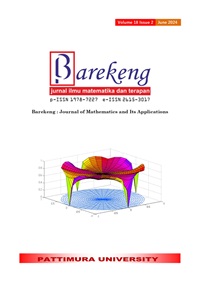ANALYSIS AND OPTIMAL CONTROL OF HIV GROWTH MODEL IN THE BODY WITH ANTIRETROVIRAL THERAPY
Abstract
Human Immunodeficiency Virus (HIV) is a virus that affects the human immune system. HIV infection causes a decrease in the body's immunity because the virus attacks immune-building cells, especially T-CD4 cells. Currently, there is no treatment that can cure or eliminate HIV, but antiretroviral therapy can be done. This study discusses the growth model of HIV in the body that is given control in an effort to maximize healthy T-CD4 cells. In this model, the infection-free and infected equilibrium points are also discussed and their stability is analyzed. Then the optimal control is solved using the Pontryagin Maximum Principle method and solved numerically using the fourth-order Runge Kutta method. Based on the analysis and simulation results, the system is asymptotically stable around the infection-free equilibrium point and unstable around the infected equilibrium point. Simulation results show that with the control of antiretroviral therapy, the T-CD4 cell population grows significantly which can improve the quality of life of patients. And the growth of HIV in the body can be inhibited until it cannot reproduce itself.
Downloads
References
A. Aulia, S. Ratna Rahayu, L. Fauzi, and G. Nita Prameswari, “Indonesian Journal of Public Health and Nutrition Determinan Perubahan Kadar CD4 pada Orang Dengan HIV/AIDS Koinfeksi TB Article Info,” IJPHN, vol. 1, no. 3, pp. 479–490, 2021, doi: 10.15294/ijphn.v1i3.49005.
R. Seitz, “Human Immunodeficiency Virus (HIV),” Transfusion Medicine and Hemotherapy, vol. 43, no. 3, pp. 203–222, May 2016, doi: 10.1159/000445852.
F. Altice, O. Evuarherhe, S. Shina, G. Carter, and A. C. Beaubrun, “Adherence to HIV treatment regimens: Systematic literature review and meta-analysis,” Patient Preference and Adherence, vol. 13. Dove Medical Press Ltd., pp. 475–490, 2019. doi: 10.2147/PPA.S192735.
S. A. Tuddenham et al., “The Impact of Human Immunodeficiency Virus Infection on Gut Microbiota α-Diversity: An Individual-level Meta-analysis,” Clinical Infectious Diseases, vol. 70, no. 4, pp. 615–627, Feb. 2020, doi: 10.1093/cid/ciz258.
M. Korencak et al., “Effect of HIV infection and antiretroviral therapy on immune cellular functions,” JCI Insight, vol. 4, no. 12, 2019, doi: 10.1172/jci.insight.126675.
CNN Indonesia, “Kemenkes Prediksi Ada 500 Ribu Kasus HIV di Indonesia,” 2023. https://www.cnnindonesia.com/gaya-hidup/20231201105421-255-1031462/kemenkes-prediksi-ada-500-ribu-kasus-hiv-di-indonesia#:~:text=Jakarta%2C%20CNN%20Indonesia%20%2D%2D,HIV%20(ODHIV)%20di%20RI (accessed Dec. 23, 2023).
Kemenkes, “Kasus HIV dan Sifilis Meningkat, Penularan Didominasi Ibu Rumah Tangga,” https://sehatnegeriku.kemkes.go.id/baca/rilis-media/20230508/5742944/kasus-hiv-dan-sifilis-meningkat-penularan-didominasi-ibu-rumah-tangga/ (accessed Dec. 23, 2023).
A. Julul Zamzami, S. Budi Waluya, and Muhammad Kharis, “Sejarah Artikel: Diterima Januari,” 2018. [Online]. Available: http://journal.unnes.ac.id/sju/index.php/ujm
M. F. Lamusu, D. Mamula, F. Muhsana, and J. Matematika, “Analisis Kestabilan Titik Tetap pada Model Matematika Penyebaran HIV/AIDS,” Euler: Jurnal Ilmiah Matematika, Sains dan Teknologi 7, no. 1 (2019): 15-24.
F. K. Rahayu, K. Yulianti, and S. Fatimah, “MODEL MATEMATIKA PERTUMBUHAN JUMLAH VIRUS HIV DI DALAM TUBUH Informasi Artikel ABSTRAK Sejarah Artikel,” Equator: Journal of Mathematical and Statistical Sciences (EJMSS), vol. 1, no. 1, 2022.
F. Rodrigues, C. J. Silva, D. F. M. Torres, and H. Maurer, “Optimal control of a delayed HIV model,” Aug. 2017, doi: 10.3934/dcdsb.2018030.
M. Lhous, M. Rachik, and A. Larrache, “Free Optimal Time Control Problem for a SEIR-Epidemic Model with Immigration of Infective,” Int J Comput Appl, vol. 159, no. 3, pp. 1–5, Feb. 2017, doi: 10.5120/ijca2017912886.
X. Wang, H. Peng, B. Shi, D. Jiang, S. Zhang, and B. Chen, “Optimal vaccination strategy of a constrained time-varying SEIR epidemic model,” Commun Nonlinear Sci Numer Simul, vol. 67, pp. 37–48, Feb. 2019, doi: 10.1016/j.cnsns.2018.07.003.
P. Panja, “Optimal Control Analysis of a Cholera Epidemic Model,” Biophys Rev Lett, vol. 14, no. 01, pp. 27–48, Mar. 2019, doi: 10.1142/s1793048019500024.
Fatmawati, C. W. Chukwu, R. T. Alqahtani, C. Alfiniyah, F. F. Herdicho, and Tasmi, “A Pontryagin’s maximum principle and optimal control model with cost-effectiveness analysis of the COVID-19 epidemic,” Decision Analytics Journal, vol. 8, Sep. 2023, doi: 10.1016/j.dajour.2023.100273.
P. Dubey, U. S. Dubey, and B. Dubey, “Modeling the role of acquired immune response and antiretroviral therapy in the dynamics of HIV infection,” Math Comput Simul, vol. 144, pp. 120–137, Feb. 2018, doi: 10.1016/j.matcom.2017.07.006.
Subiono, “Sistem Linear dan Kontrol Optimal,” Intitut Teknologi Sepuluh Nopember. 2023.
D. Subarray Naidu, Optimal control systems. 2002. doi: 10.1515/9783110306637-005.
Copyright (c) 2024 Erlyana Trie Damayanti, Chairul Imron

This work is licensed under a Creative Commons Attribution-ShareAlike 4.0 International License.
Authors who publish with this Journal agree to the following terms:
- Author retain copyright and grant the journal right of first publication with the work simultaneously licensed under a creative commons attribution license that allow others to share the work within an acknowledgement of the work’s authorship and initial publication of this journal.
- Authors are able to enter into separate, additional contractual arrangement for the non-exclusive distribution of the journal’s published version of the work (e.g. acknowledgement of its initial publication in this journal).
- Authors are permitted and encouraged to post their work online (e.g. in institutional repositories or on their websites) prior to and during the submission process, as it can lead to productive exchanges, as well as earlier and greater citation of published works.






1.gif)



